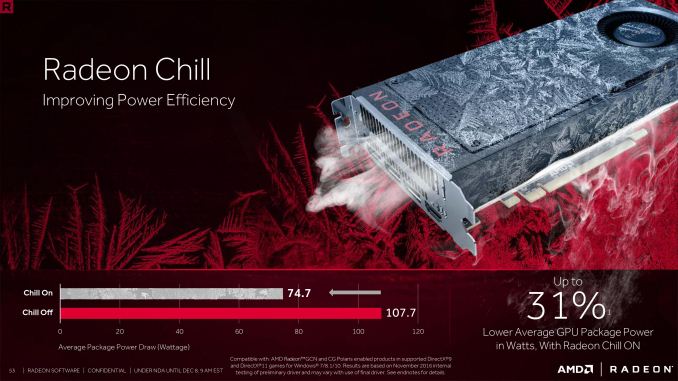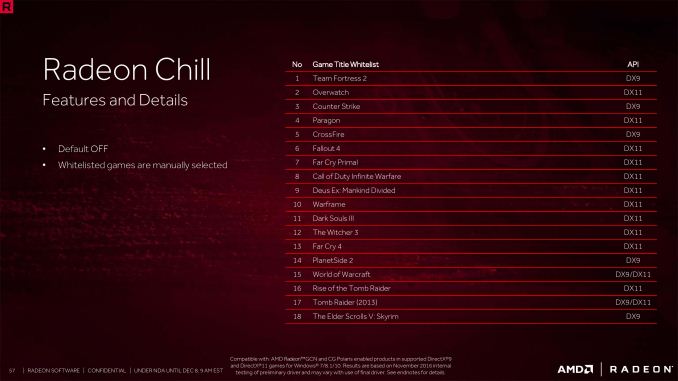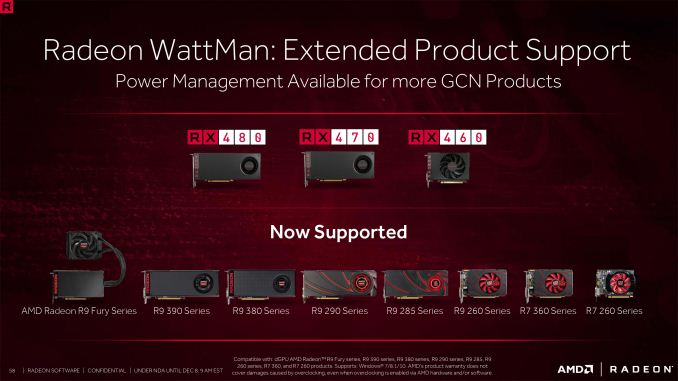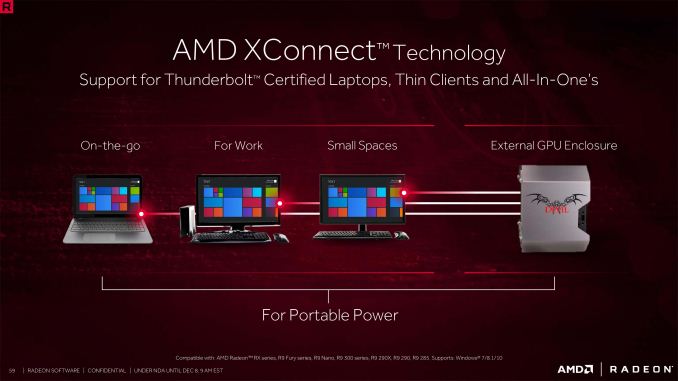AMD Delivers Crimson ReLive Drivers: Yearly Feature Update for Radeon Gamers and Professionals
by Ian Cutress on December 8, 2016 9:00 AM ESTReLive New Features (3)
Earlier this year, during the Polaris set of pre-briefings, AMD mentioned that it had acquired a company called HiAlgo. HiAlgo had designed a set of software and driver hooks to decrease FPS/power or increase response time by dynamically adjusting resolution by monitoring graphic workloads and gameplay mechanics. At the time the software only worked on DirectX 9, but since the purchase AMD is now bringing part of the package to its driver set. First up is CHILL.
Radeon CHILL
The concept of CHILL is fairly simple. During periods of low user interaction or little action on screen, the CPU and GPU power limit is reduced, causing the hardware to slow down. This reduces the frame rate during periods where a high frame rate is not required, allowing the CPU/GPU to cool down (where the CHILL bit comes in). This also saves power on power-limited systems such as laptops. When CHILL detects more action or more strenuous movement by the user, the power limit is moved back up.
We still need to test the software internally, but the idea means lower temperatures and lower average power consumption. One side-effect of this means that fewer frames are queued in the buffer, which AMD claims it results in a quicker response time from frame generation to frame output.
CHILL will be enabled in ReLive for any GCN enabled product, initially for only specific DX9 and DX11 titles. As a first release of CHILL, AMD is being somewhat cautious and shipping with the feature turned off by default and relying on a list of approved games at this time. We were told that as time goes on it may be turned on by default and games known to be incompatible will be denied by the software.
WattMan: Extended to More Cards
One of the big updates for the release of AMD’s Polaris GPUs was the WattMan (what, man?) power management software, taking over from previous overclocking tools.
As part of ReLive a number of 200 and 300-series discrete GPUs will now be enabled with WattMan as well as the R9 Fury series.
AMD XConnect Technology
During the gamut of external GPU enclosure announcements around Thunderbolt 3 during the year, AMD’s XConnect technology emerged as a leading figure. However, up until now, it mainly requires specific driver sets under specific hardware configurations.
With ReLive this is opened with XConnect now supporting any Thunderbolt certified laptop, thin client and all-in-one when used with an enclosure that supports an AMD Radeon discrete card with GCN 1.2 or above.














48 Comments
View All Comments
PseudoKnight - Thursday, December 8, 2016 - link
"took a few seconds..." cracked me uplol, now i'm imagining you starting up your download manager just in case your sister makes a phone call and you have to resume the download later.
A5 - Thursday, December 8, 2016 - link
It's possible the board designs spec a different HDMI/DP chip that supports it or something.Probably just a testing or marketing thing though.
Colin1497 - Thursday, December 8, 2016 - link
Yeah, I have a box with a 285 in it (my son's). Doesn't have an appropriate monitor today, but the monitor is the next thing to get replaced, so it was personal interest driving the Q. :)Manch - Thursday, December 8, 2016 - link
Was wondering the same thing. Why the rebadge only. Ill start the download :D as soon as I get home. Then I'm requesting the feature for my 290X'snathanddrews - Thursday, December 8, 2016 - link
The only differences over Hawaii that I know of are that Grenada has refined power delivery, power management, and faster 6 GHz VRAM. Pretty sure that Grenada and Hawaii share the same encode/decode blocks and display outputs, but it's possible that Grenada shipped with higher speed DisplayPort ports and it was never published due to the lack of concrete validation methodology at the time, but I doubt it. Pretty sure AMD/NVIDIA just buy DP/HDMI port hardware/controllers in bulk and order whatever is available at the time.Technically, HDR10 metadata can be streamed using older display connections (just like Dolby Vision), but without monitor/TV support, I'm curious to what AMD has planned. My guess is HDR10 will be limited to 8-bit Rec.709 on Grenada, whereas Polaris will get support for HDR10 10-bit Rec.2020, based upon port capabilities alone.
Why TongaXT is included in the mix and not Hawaii, I don't know.
testbug00 - Sunday, December 11, 2016 - link
Tonga is GCN gen3, Hawaii is GCN gen2.Gen1=Cape Verde, Pitcairn, Tahiti.
Gen2= Bonaire, Hawaii
Gen3= tonga, Fiji
Gen4= P11, P11
There is orland and I think one more 28nm GPU, but I do not know if they are gen 1, 2 or 3z
R3MF - Thursday, December 8, 2016 - link
"On the HDR front, AMD has been promoting that high end R9-300 series"What is it about a 390 series card that is absent in the 290 series card, to make the former compliant with HDR when the latter is not?
Is this purely HDR10 support, or does it include Dolby Vision as EA have said Mass Effect Andromeda will use on the PC? If not, do AMD think this matters?
ET - Thursday, December 8, 2016 - link
Hardware compatibility looks incomplete. It makes no sense for example that user feedback isn't available on APU's, or that VP9 4K60 works on discrete and Stoney Ridge but not on Bristol Ridge.R3MF - Thursday, December 8, 2016 - link
Re: Linux supportDoes "SLED/SLES 12" support indicate there will be a driver compatible with Opensuse Leap 42.2?
PseudoKnight - Thursday, December 8, 2016 - link
I really appreciate AMD adding features and improvements to even their five year old cards (own a 3 year old card). I've also liked this new direction they've been taking with their software since Crimson. It never felt quite finished (with some things being tacked on) but this looks like it might finally rounds things out. I'm particularly looking forward to testing out ReLive DVR. I suspect I'll stick with OBS Studio, but here's hoping it surprises me.